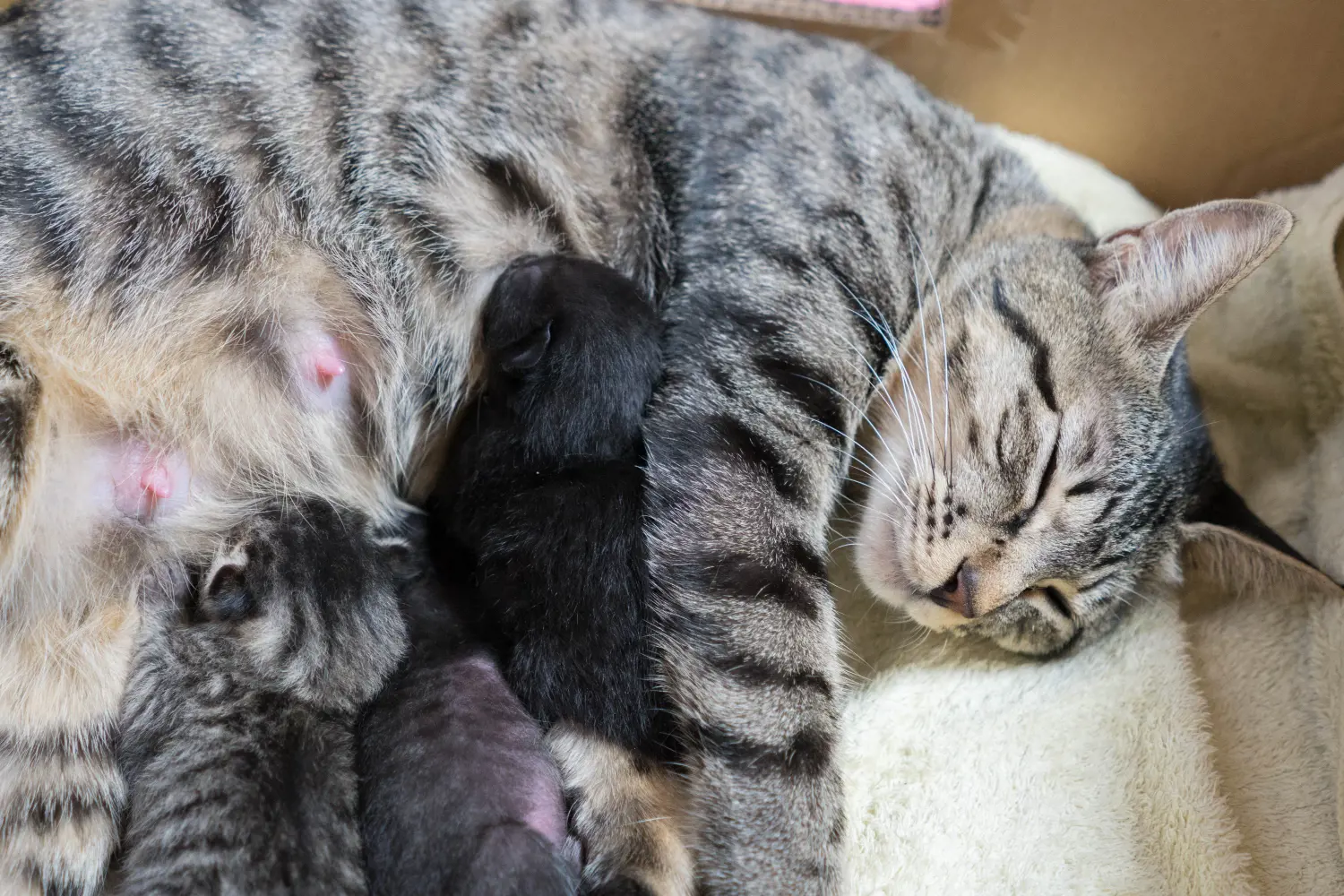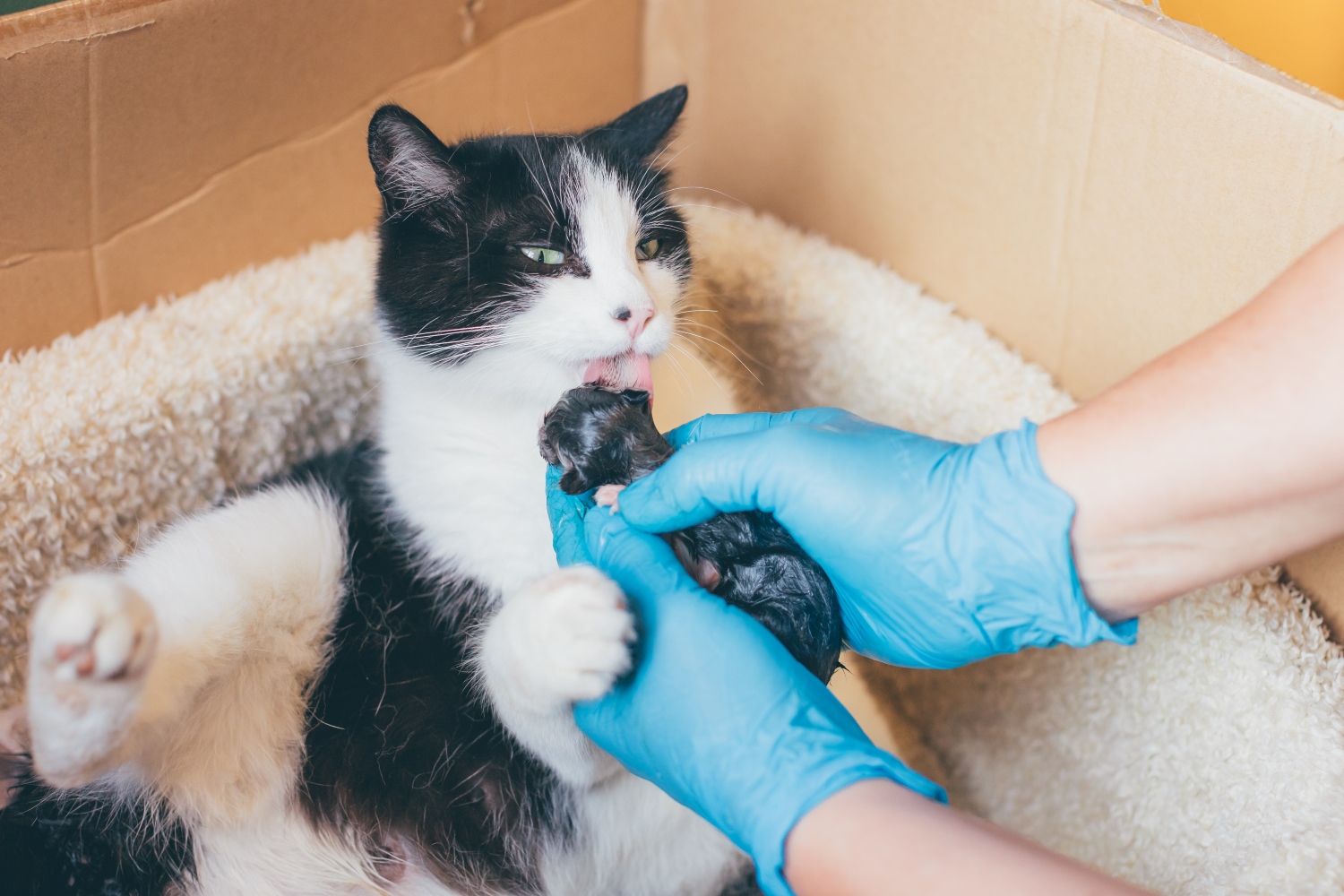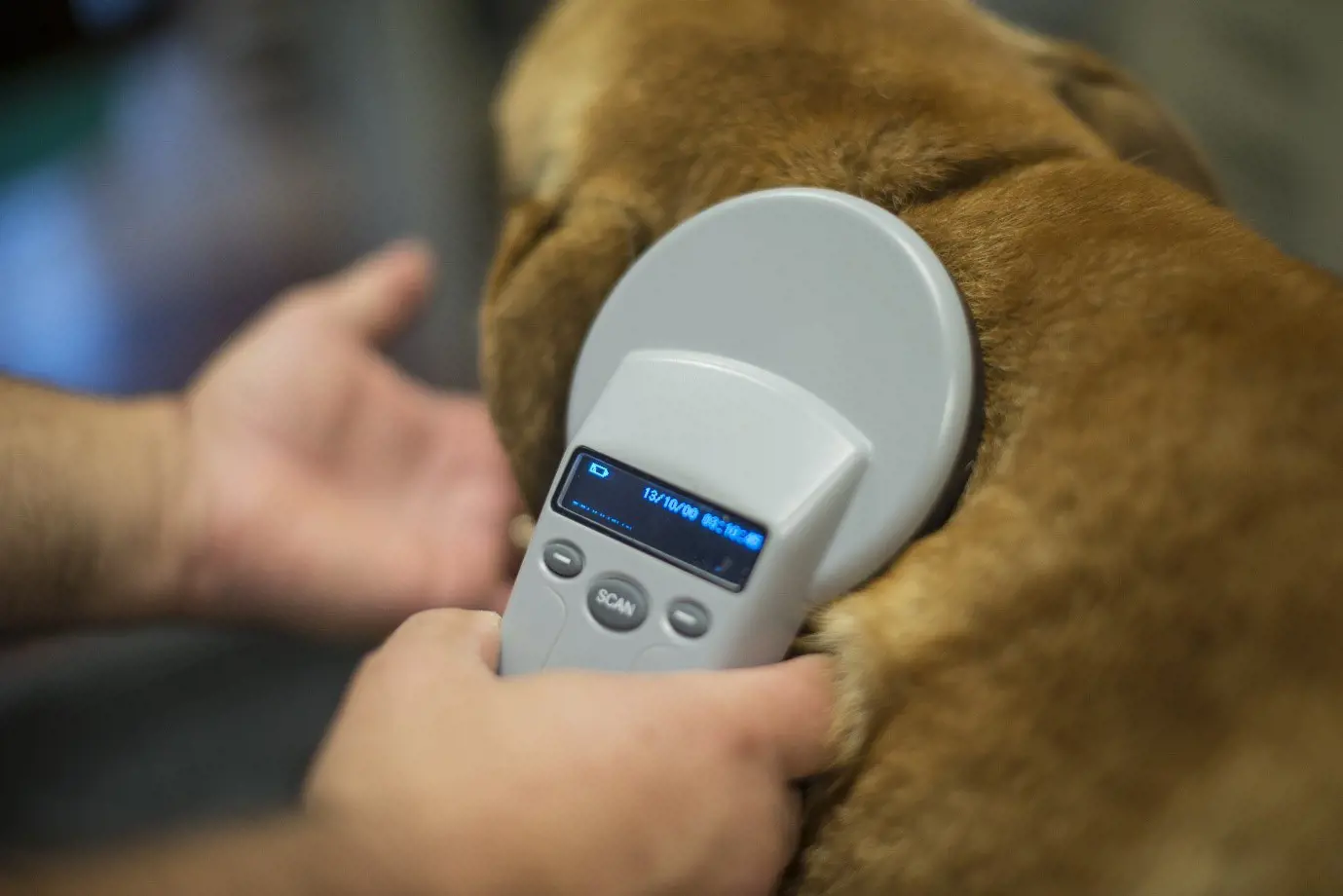5 signs that your cat is in labour
27th March, 2023

Are you awaiting the pitter patter of tiny paws? Learn how to tell your cat is going into labour and what you can do to ensure a safe delivery for your pet and her litter.
Discovering your feisty feline is pregnant is exciting but it can also be daunting for many pet parents, especially if you’ve never experienced cat pregnancy, labour and delivery before.
Don’t worry, though – your cat is perfectly capable of doing it all alone and may even try to find a secret spot somewhere in your home to birth her litter! But that doesn’t mean it’s okay for her to hide away. You’ll need to keep a watchful eye on your pet to make sure she’s comfortable, in a safe spot, and visible so you can help if anything happens.
Not sure where to start? We’ve got you covered with tips for prepping before the birth, spotting the signs she’s in labour and caring for her once all the kittens are out.
How do I know my cat is pregnant?
Is your beloved cat looking a little rounder than usual? Perhaps she keeps being sick after meals? She might be pregnant!
If your feline hasn’t been spayed, you’ll need to know how to tell she’s pregnant. It can be difficult during the early weeks, but before long, you should start seeing signs.
Blue Cross says to watch for:
- Visible weight gain
- Morning sickness with vomiting (yes, our feline friends can suffer from this too!)
- Swollen, pink nipples
- Eating more than usual
- Sleeping more
- Personality changes, like showing more affection
As labour draws closer, your cat might also start pacing and seem a little anxious, looking for a spot to deliver her kittens (we’ve got tips for you to help below). You might also spot red discharge from her vulva, which means the birth is near.
As soon as you suspect your pet is pregnant, take her for a check-up at the vet. Pregnancy and related conditions aren’t included with cat insurance, but it’s important to cover your feline to keep her in good health before, during and after pregnancy.
It is important to note that if your cat has had more than two litters then it is deemed as commercial breeding and therefore your pet will be excluded from cover. Moreover, cat insurance cover solely is for accidents and illnesses that are non-pregnancy related.
Bonus fun fact: Pregnant cats are called queens!
Preparing for the birth
Before the big day arrives and your cat goes into labour, you’ll need to prepare a birthing space and be ready to face any problems head on. Here are our top tips.
Know her due date
When you take your pregnant cat to the vet, they should be able to tell you when her due date is. Felines are pregnant for around 65 days, so if you keep track, you’ll know when to expect a cluster of kittens!
Stay on top of general health care
We understand your main focus will be on the pregnancy and preparing for kittens right now, but you still need to look out for your cat’s general wellbeing. This means:
- Going for regular vet check-ups.
- Protecting her with cat insurance in case of a non-pregnancy related emergency.
- Staying up to date with vaccinations, flea and worming treatments (this also protects the newborns when they arrive).
- Making sure her nutritional needs are met – she’ll need more calories and high quality food as the birth gets closer.
Prepare the birthing area
Don’t wait until the last minute to get a birth box ready. Your feline needs time to get used to the area and see it as a safe spot for her and her kittens. Otherwise, you might catch her sneaking off like we mentioned earlier!
Whether you buy a birth box online or make it yourself, you need to make sure it’s:
- In a quiet, warm and comfortable room of your house.
- Close enough to her food, water and litter box for easy access (not too close).
- Spacious enough to fit your cat and the kittens inside.
- Lined with clean absorbent bedding, like towels and blankets.
- Covered if it doesn’t have a top.
- Got high sides to stop nosey kittens from escaping.
Some cats never get used to their birthing box. Just make sure she has options of where to birth and accommodate a different space if she prefers another spot in your home – even if it’s under the sink!
Gather supplies for the birth
When you think labour is fast approaching, it’s time to get a few things ready in case you need to help. You can check them off below:
- Absorbent pads and towels for the delivery space
- Clean towels in case you need to wipe the area or the kittens
- A bowl of clean, warm water
- A heating pad under the box and an infrared lamp to keep the kittens warm
- A bin or laundry basket (things can get messy)
- Dental floss
- Scissors
- Cat milk powder in case there are problems nursing the kittens
Keep your vet on speed dial
If you feel unsure about any part of the birthing process or are worried something’s wrong, give your vet a call.
5 ways to tell your cat is going into labour
The big moment has finally arrived. Or has it? Here are the signs the first stage of cat labour is under way:
- Your cat becomes restless and more vocal – she may look like she’s looking for something and meow a lot more than normal.
- She keeps going to the litter box but not peeing or pooping. She should soon settle into her birthing box.
- You notice brown/red discharge coming from her vulva. If you see blood, it could mean something's wrong, so call your vet immediately.
- Your feline starts excessively grooming her back end, which could be due to the vaginal discharge or the sensation of her cervix widening.
- She goes off her food. Even if you serve up her favourite feast, she won’t be interested!
How long does the first stage of cat labour last? It can take up to 36 hours, and it might be a few hours before you realise what’s happening.
Understanding the labour and delivery process in cats
The tell-tale signs mentioned above are part of the first stage of labour. There are three stages in total, and once you think the process has started, you’ll need to keep a close eye on things.
Your cat will usually have a smooth labour and delivery, but it’s important to watch in case of complications. Keep a good distance, though, and make sure there aren’t too many people present. We’re sure the whole family is eagerly awaiting the new arrivals but you could make mother mog uncomfortable.
It’s also important to only intervene when absolutely necessary. Getting involved when it isn’t needed could actually slow the process and upset your feline, and we’re sure you don't want that!
Let’s take a closer look at the stages of cat labour.
Stage 1 – Birth preparation
During the first stage, your cat will start showing the signs mentioned above as her cervix relaxes and widens. She’ll experience contractions (you won’t be able to see these) and start to settle into her delivery spot as the moment approaches.
Don’t be surprised if your cat ventures to a different area instead of the maternity box you so carefully put together! Let her choose where to deliver her kittens or you could really upset her.
Stage 2 – Delivering the kittens
Contractions start building, becoming more frequent and more intense. You’ll soon see your cat start straining – this means you should see the first kitten in the next half an hour!
While most kittens come head first (just like humans), some come out feet first. This shouldn’t pose a problem to your cat. Most kittens appear within 30-45 minutes of the previous one, but it can take up to an hour.
Make sure you have your birthing kit to hand, but keep a safe distance unless you see a serious sign you need to interfere, like:
- Straining but no kitten for over an hour
- Bloody discharge
- Delivering kittens in quick succession without time to clean them and break their amniotic sac
If something isn’t going to plan, give your vet a call. Emergency birthing care isn’t included in cat insurance, but that doesn’t mean you shouldn’t get your pet help if she truly needs it.
Stage 3 – Passing the placenta
The third and final stage of cat labour is passing the placenta, which usually happens after every kitten (they have one each).
Keep a tally of placentas and kittens – there should be the same amount. If there isn’t? Mum could have eaten one (yes, they may eat placentas and umbilical cords) or twins might have shared one.
However, this could also mean she has a retained placenta, which needs to be checked by your vet immediately.
How long is a cat in labour for?
Stage one can take up to 36 hours and kittens should be born within 24 hours (most arrive within 2-6). So, although it can be quick, don’t be surprised if it lasts a good two days!
Potential problems during cat labour and delivery
Luckily, most cats deliver their kittens smoothly, but problems can arise, which we call dystocia.
According to International Cat Care, difficulties are more common where selective breeding is concerned, so in breeds like Siamese and Persians. But this doesn’t mean your mog will necessarily face issues just because it’s a pedigree cat.
Make sure you’re watching closely (from a distance) so you can help or call your vet if you notice any of the following problems:
Green discharge or blood
Both of these act as a warning sign that something’s wrong. Green discharge might mean there’s a problem with the kittens, like a dropping oxygen supply.
While a bit of blood is normal during birth, if you notice more than a few drips, it’s time to speak to the vet.
Straining unsuccessfully
Your cat needs to strain to push the kittens out of the birth canal, but if she’s straining for 45 minutes to an hour and there’s still no sign of her babies, something might be blocking their passage that needs emergency help.
Constant pushing with no success can also cause extreme exhaustion in your faithful feline, meaning she stops straining altogether and puts her litter at risk.
Stuck kittens
If kittens are particularly large or have a deformity, they can get stuck in the pelvis. You might see one emerging but never actually make it out. Don’t attempt to pull it – call your vet immediately.
Problems with the amniotic sac or umbilical cord
Sure, your clever cat seems like a natural at giving birth, but first-time mums might need a little help removing the amniotic sacs. After giving your pet the chance to do it alone, you may need to step in to stop the kitten from suffocating.
Some felines struggle with removing the umbilical cord, too, so be prepared to help if they take too long – we’ll tell you how below.
Stillborn kittens
Although it’s sad to see, it’s not uncommon for cats to have one or two stillborn kittens in her litter. To be on the safe side and make sure no underlying illness has caused this, ask a vet to check your cat after the birth.
Your cat insurance might be able to help with treatment costs if it’s non-pregnancy related.
What happens if my cat can’t deliver her litter?
If you notice your cat struggling at any point or that she doesn’t go into labour within a few days of her due date, contact your vet. Make sure you provide as many details about her condition as possible and let them know what seems to be the problem.
You can expect them to do an ultrasound or x-ray to check everything is okay internally and monitor her in hospital. Your vet may recommend medication to help speed things along, but your beloved cat might need a caesarean if nothing else is working.
Can I help my cat during the delivery?
Cats are pretty self-sufficient when it comes to birthing kittens. Only step in if absolutely necessary.
You might need to help with:
Breaking the amniotic sac
Mum will usually break this sac before cleaning the kitten thoroughly. If she doesn’t, use a towel to gently pull apart the sac to allow the kitten to breathe. With a wet cloth, clean it against the grain of fur before drying it with a towel.
Cutting the umbilical cord
If mum doesn’t bite through the cord, you’ll need to wash your hands or pop on some disposable gloves. Tie dental floss a couple of inches away from the kitten's body and then again another inch away, before cutting the cord in the middle. Don’t tie too close to the kitten or you may harm them.
Reviving limp-looking kittens
Before you declare any kittens as stillborn, it’s worth double-checking. You may be able to revive them by briskly rubbing them up and down with a damp, warm flannel and blowing into their mouth and on their face.
If you’re worried about helping your feline friend with any of the above, don’t hesitate to call your vet.
After care for your cat and kittens
Your main job after your cat has given birth is making sure everyone is warm and comfortable. Keep a close eye on how they’re doing to make sure all the little felines are thriving, but let your cat settle into her new role as a mother.
You can check for signs she might be feeling uncomfortable in our cat body language article.
Check the room temperature often and regularly change their bedding so it’s always clean and dry. Stop family members and other pets from entering her space and keep it as quiet as possible.
Cats Protection advises that you call your vet if you spot the following:
- Unusual vaginal discharge or bleeding
- Straining (this could be a prolapsed womb)
- Mastitis (swollen, sore and hot mammary glands)
- Mother or kittens with a poor appetite or vomiting
- Twitching, stiffness and collapsing
You can learn more about caring for kittens as they grow up elsewhere on our site.
What is eclampsia?
This condition can develop during late pregnancy, but is most common among nursing cat mums. It’s sometimes called puerperal tetany or hypocalcaemia and causes blood calcium levels to plummet.
Watch your post-natal cat for:
- Panting
- Stiffness when moving
- Excessive salivation
- Restlessness
- Muscle twitching
- Fever
Eclampsia progresses quickly and can be life-threatening if not seen by a vet, so get help as soon as you notice any symptoms, however mild.
Can I stop my cat from getting pregnant?
Sure, a bundle of tiny kittens is outrageously adorable, but pregnancy and giving birth pose a lot of risks to your cat. Unless you plan on breeding your feline, which you need to consider very carefully, it’s best to get your mog spayed.
Neutering is a surgical procedure that removes your pet’s ovaries and uterus, preventing her from getting pregnant. It’s a major operation and you’ll need to provide plenty of after care.
Apart from removing the risk of pregnancy, spaying holds the following benefits for your faithful feline:
- Removes the risk of ovarian and uterine cancer.
- Reduces the risk of developing other illnesses like mammary cancer.
- Removes the desire to roam outdoors to find a mate.
- Stops her going into heat and attracting males.
And although spaying isn’t included on cat insurance, it could help reduce your premiums as your pet is less likely to need emergency care.
You can spay a kitten from as young as 8 weeks old, so if you’re certain you don’t want your pet to fall pregnant, speak to your vet about the best time to get the surgery for your cat.
Specialist cat insurance for your feline friend

With 15 levels of lifetime cat insurance to choose from, it’s easy to protect your cat at Purely Pets.
With 24-hour vet video consultations and an online policy portal, you can manage your insurance where and when it suits you. There’s no upper age limit, either, so even the most senior cats can get the cover they need.
Cat insurance is just a few clicks away. Contact Purely Pets for a quick quote today.
Helpful Pages
Recent Posts
Pet Insurance Quote
- 98% claims paid *
- Claims paid directly to vets
- 24/7 vet video consultations
- Interest free monthly payments




